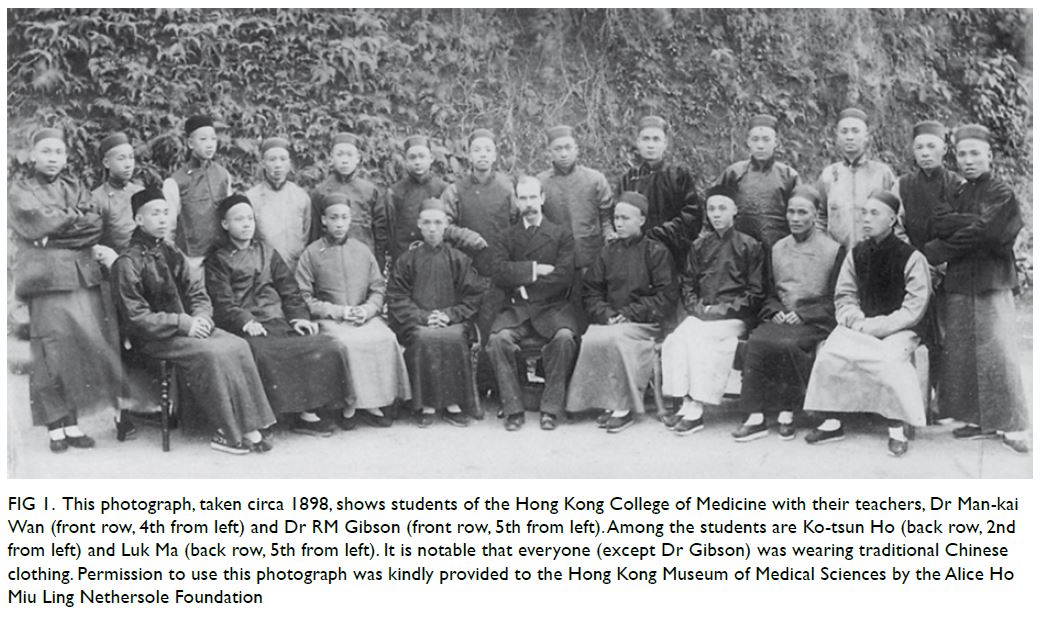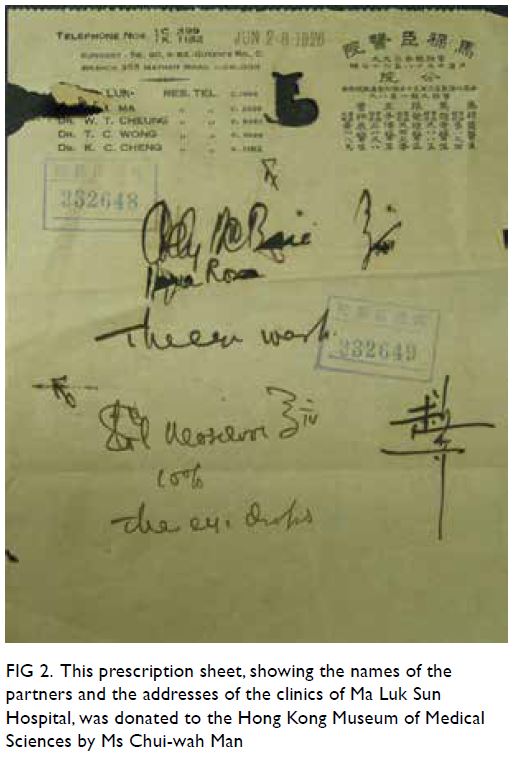© Hong Kong Academy of Medicine. CC BY-NC-ND 4.0
REMINISCENCE: ARTEFACTS FROM THE HONG KONG MUSEUM OF MEDICAL SCIENCES
Dr Man-kai Wan and the medical students of the Hong Kong College of Medicine at Nethersole Hospital in 1898
TW Wong, FHKAM (Emergency Medicine)
Member of the Education and Research Committee, Hong Kong Museum of Medical Sciences Society
The Hong Kong College of Medicine for Chinese
students was established in 1887 with the London
Missionary Society’s (LMS) Alice Memorial Hospital
as its teaching hospital. Nethersole Hospital was
opened in 1893 to relieve the congestion in the Alice
Memorial Hospital.
Dr Robert Mclean Gibson (1870-1936) arrived
in Hong Kong in 1897 to become the medical
superintendent of the LMS hospitals. In his long
association with the College, he was a lecturer, the
Director of Studies, and a member of the College
Court. When the College merged into the University
of Hong Kong in 1911, he became founding member
of the University Court.1 This group photo taken
circa 1898 shows students of the LMS-affiliated
Nethersole Hospital with their teachers (Fig 1).
Sitting in the middle in the front row is Dr Gibson,
and on his right is Dr Man-kai Wan (尹文楷; 1870-1927), the house surgeon.

Figure 1. This photograph, taken circa 1898, shows students of the Hong Kong College of Medicine with their teachers, Dr Man-kai Wan (front row, 4th from left) and Dr RM Gibson (front row, 5th from left). Among the students are Ko-tsun Ho (back row, 2nd from left) and Luk Ma (back row, 5th from left). It is notable that everyone (except Dr Gibson) was wearing traditional Chinese clothing. Permission to use this photograph was kindly provided to the Hong Kong Museum of Medical Sciences by the Alice Ho Miu Ling Nethersole Foundation
Dr Wan (alias Tun-mo Wan尹端模) is best
known in Hong Kong as the founding president
of the Hong Kong Chinese Medical Association
(HKCMA), the predecessor of the Hong Kong Medical
Association, a century ago. However, his medical
career actually began in Tianjin. After graduating
from the Government Central School (now Queens
College) in 1884, he enrolled into the Viceroy’s
Hospital Medical School in Tianjin.2 The medical
school was started by the London Missionary Society
in 1881 with the sponsorship of Li Hung Chang. It
was renamed Pei Yang Medical College in 1893 after
the Qing government took over its management.
Among his classmates was Dr King-ue Chung, who
became the first Western-trained doctor to work in
Tung Wah Hospital in 1897. Dr Wan graduated in
1889 and served in the navy for a short stint before
returning to Canton. From 1891 to 1896, he worked
at Pok Chai Hospital, a missionary hospital and medical school run by Dr John Kerr. In addition
to providing clinical service, he helped Dr Kerr to
translate several medical textbooks into Chinese. He
also had the honour of being the first Chinese doctor
to publish a lay magazine in Canton to disseminate
Western medical knowledge to the general public.
During this time, he also collaborated with Dr Yat-sen
Sun in running a clinic to cover his revolutionary
activities. After the failed Canton uprising in 1895,
Dr Sun was forced to flee from China. Dr Wan also
decided to relocate to the safer Hong Kong.
He started his Hong Kong career by joining
Nethersole Hospital in 1897 after Dr Chung, his
classmate, left to join Tung Wah Hospital. He
became a tutor for the College and taught various
practical subjects. He left Nethersole Hospital in
1902 to start a private practice in Central District.
After the establishment of the Republic of China in
1912, a National Medical Association was formed
in 1915 in mainland China. This probably was the
inspiration for local doctors to organise themselves
to form an association of Chinese doctors. As a
revered local practitioner, Dr Wan was elected and
served as the founding president of HKCMA from
1920 to 1922. The same group of local doctors also
started the Yeung Wo Nursing Home in 1922, which
was the first private hospital run by Chinese doctors.
Dr Wan was also active in the local Christian
community and was elected president of the Young
Men’s Christian Association in 1922.
Among the students in the photograph (Fig 1),
a few were not from Hong Kong, including HK Tee
from Amoy, YS Lee from the United States, and
ST Lim from Burma. Some left Hong Kong after
graduation to seek employment in other countries,
such as HK Tee who went to the Philippines and WO
Wong and KS Chan who went to Singapore. Most
stayed in Hong Kong and worked in hospitals, clinics
or the Bacteriology Institute.3 A few graduates,
including Dr Ko-tsun Ho (何高俊; 1878-1953) and
Dr Luk Ma (馬祿; 1883-1963) became leaders of the
local medical community.
Dr Ho graduated in 1902 and joined
Nethersole Hospital in 1903 after Dr Wan had left
for private practice. He had a close relationship with
the hospital because his uncle, Dr Kai Ho, was one
of the founders. He was best remembered for his
long association with the Eastern Chinese Public
Dispensary (CPD) in Wanchai even after starting
his own private practice in 1908. The CPDs were
first established in Western District and Wanchai
in 1905 to deal with the dumping of dead bodies
and provide care for patients with plague. It was
run by the CPD committee and eventually the roles
expanded to include medical care and vaccination.4
Dr Ho joined the Wanchai CPD in 1907 and lobbied
for a larger premises at Stone Nullah Lane, which
was completed in 1911. After the revolution in China, he took up the post of vice minister of health
for Guangdong from 1911 to 1916. On returning
to Hong Kong, he re-joined the Wanchai CPD and
remained working there until his retirement in 1949.
In 1919 a maternity unit was added to the CPD to
provide a Western midwifery service. It was a great
success and the CPD committee decided to build
a bigger unit in Western District which opened in
1922 as Tsan Yuk Hospital. He was honoured with
an OBE in 1949 for his long service for the poor in
Wanchai and especially for the tremendous effort he
spent to maintain the service during the Japanese
occupation. He also played a leading role in the local
medical community. He was the Chairman of the
Yeung Wo Nursing Home Board of Directors at its
inauguration in 1922. He was elected vice president
of the HKCMA in 1923.
Dr Ma graduated 3 years later than Dr Ho. After
spending a few years working for the CPD, he had
the rare distinction of being the first Chinese doctor
to join a European group practice (Drs Fitzwilliams
and Allan) in 1908. He started his own clinic in
Central District 2 years later. He gradually expanded
his practice by taking in assistants and partners and
formed a large group practice, Ma Luk Sun Hospital
(馬祿臣醫院).3 This was probably the first medical group practice established by local Chinese doctors (Fig 2). Later, a branch hospital was opened also in
Nathan Road, Kowloon. Dr Ma was also a director
of the newly formed Yeung Wo Nursing Home in
1922. He served the HKCMA as vice president for
the 1933-4 term, and was also active in other social
circles. For example, he was an active member
and later served as Chairman of the Chinese Club
which was established in 1897 to rival the European
dominated Hong Kong Club. He was admitted to the
Order of St John for his long service for the St John
Association and Brigade. He was also well known as
an art collector.

Figure 2. This prescription sheet, showing the names of the partners and the addresses of the clinics of Ma Luk Sun Hospital, was donated to the Hong Kong Museum of Medical Sciences by Ms Chui-wah Man
Among the 128 students enrolled at Hong
Kong College of Medicine from 1887 to 1912,
only 60 graduated. One of the reasons for this
significant dropout rate maybe due to the fact that
the qualification was not recognised under the
Medical Registration Ordinance of 1884; the Hong
Kong College of Medicine diploma was recognised
only after amendments to the Ordinance in 1914.
Nevertheless, despite an initially unfavourable
practice environment, some of the students that
graduated became part of the early medical elite in
Hong Kong.
References
1. Evans DM. Constancy of Purpose: an Account of the Foundation and History of the Hong Kong College of Medicine
and the Faculty of Medicine of the University of Hong Kong, 1887-1987. Hong Kong: Hong Kong University Press; 1987.
2. Ho F. Graduation Certificate of Dr Wan Tun Mo. Footprints of Medicine. Hong Kong Museum of Medical Sciences
Society; 2016.
3. Ho F. Western Medicine for Chinese: How the Hong Kong College of Medicine Achieved a Breakthrough. Hong
Kong: Hong Kong University Press; 2017. Crossref
4. Chan-Yeung M. Eastern District (Wan Chai) Dispensary and Plague Hospital. Hong Kong Med J 2019;25:503-5. Crossref

